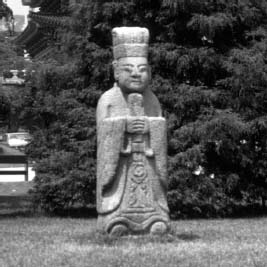Confucianism, the Literati, and Chinese Imperial TraditionsCustoms and Rituals |
What kinds of ritual objects figure in Confucian and CIT worship? |
When Confucius was young he was particularly intrigued by the classic bronze vessels his ancestors had used for centuries in honoring Heaven. Most of these vessels held materials to be offered. The principal forms developed in connection with the particular types of material. A vase (yu) was to hold sacrificial wine; a jug (zhue) poured libations; and a beaker (gu) may have been used for sharing a communion-like drink. The ding was a bowl for ritual foods such as cereal grains or fruit. Some of these objects apparently were designed in particularly symbolic shapes, such as the “hill-shaped” censer, whose form recalled the Five Sacred Mountains. Some bronzes bear abstract representations of the four directional creatures: the black tortoise of the wintry north, the green dragon of the vernal east, the scarlet bird of the summery south, and the white tiger of the autumnal west. Inscriptions dedicating an object to a father, for example, or expressing the hope that sons and grandsons will use the vessel for “ten thousand years,” suggest that they were commonly used in ancestor veneration rituals. Even today, copies of those antique objects adorn the altars in Confucian temples and are part of the relatively infrequent offerings held there. Many of the sacred vessels were buried in tombs or even thrown into river beds during invasions to prevent them from falling into the hands of barbarians. Nearly every large museum has good examples in its Asian collections, and they are well worth a visit.

Stone Sage or ancestor figure on the grounds of the National Palace Museum in Seoul, South Korea.
